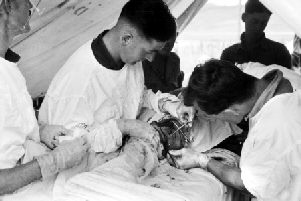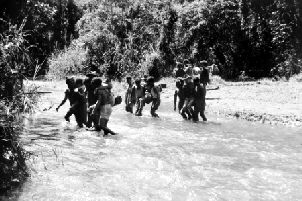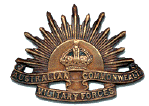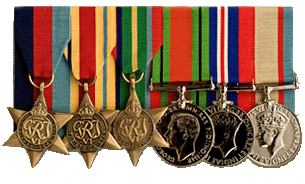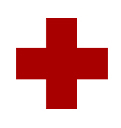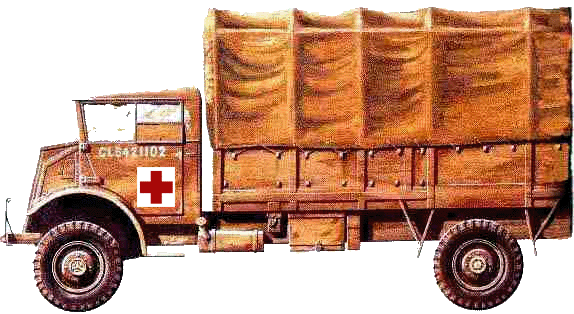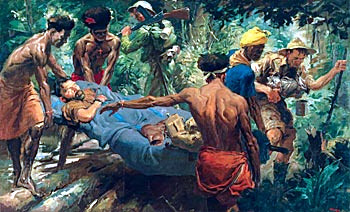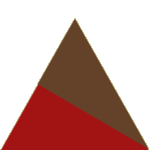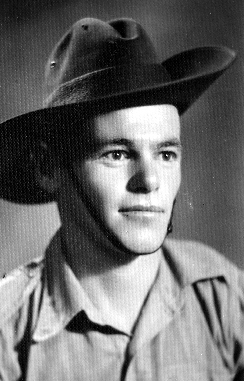2/4 Field Ambulance. Served in the Middle East, Syria and New Guinea. Ivan was known for his beautiful voice throughout his home town of Woorinen. He could impersonate some of the worlds most famous tenors, and would often be heard singing throughout the settlement. He was nicknamed the Parson – because of his gentle nature and because he would never drink or curse. Ivan joined the 2/4th Field Ambulance helping care for wounded and sick troops during his time in the Middle East, Syria and New Guinea, spending weeks on the Kokoda Track. In June 1943 Ivan returned home to run the family farm. He later married Marie. They had 4 children and settled in Robinvale in Victoria. Ivan’s memories from his service as a Medic affected him terribly throughout the remaining years of his life. In 1957 he was diagnosed with motor neurone disease. He suffered for twelve years with the disease before dying on the 30th of September 1969, aged 53. Ivan is buried with his wife Marie at the Robinvale lawn cemetery.
Campaigns
Syria
After the surrender of France in June 1940, the French colonies of Lebanon and Syria passed into the control of the pro-German Vichy French government. The British saw these colonies as a threat to their interests in the Middle East and as possible areas from which the Germans might attack Egypt and threaten oil supplies from Iraq. On 7-8 June 1941, Australians of the 7th Division, along with British and Free French forces, striking north from Palestine, invaded Syria and Lebanon. The operation was supported by RAAF and RAF units and by British and Australian warships off the coast of Lebanon.On 9 June, the Australians were involved in heavy fighting at the Litani River in southern Lebanon. Further intense action occurred between 11-27 June at Merdjayoun, Lebanon, where Australian and British troops attacked and counter-attacked Vichy forces. On 21 June, the Syrian capital of Damascus fell to a combined Indian, British, Australian and Free French force. Fighting, however, continued in Lebanon as the Allies struggled to take the important coastal centre of Damour. With the fall of Damour on 9 July 1941, the Vichy commander, General Dentz, asked for an armistice which was signed at Acre on 13 July 1941. Altogether about 18,000 Australian troops took part in the Syrian campaign
New Guinea
The last battle of 1942 involving Australians was for the Japanese beachheads at Buna, Gona and Sanananda in northern Papua. The Allies expected the battle would be easily won but underestimated Japanese strength and resolve and grossly overestimated Allied capabilities. The battle opened on 19-20 November with attacks against Buna by the Americans, against Gona by the Australians, and against Sanananda by Australians and Americans. Tropical diseases, rain, mud and supply difficulties impaired both sides and the battle dragged on. By the time the last Japanese positions fell in January 1943, about 1300 Australians and 1000 Americans lay dead, with thousands more evacuated wounded or sick. More than 6000 Japanese had fought to the death. It was the single most costly battle for Australians in 'the islands'.
By early 1943, Japanese forces still held most of New Guinea, including the main coastal settlements of Lae and Salamaua. Australians defeated a Japanese force at Wau in late January and early February 1943. By May 1943, the Allies had captured Japanese positions near Salamaua and on 11 September 1943 they captured Salamaua. Also in September, a joint Australian and American air, land and sea operation with the 7th and 9th Australian Divisions recaptured Lae. The 7th Division was then ordered into the Markham-Ramu Valley to pursue Japanese forces across the Finisterre Range where the fighting for Shaggy Ridge continued on into 1944.
European women and children are evacuated from Salamaua airfield ahead of the expected invasion of the territories of Papua and New Guinea in December 1941. They were flown to Port Moresby and then sailed to Australia, where they remained for the duration of the war.
The 9th Division, the 'Rats of Tobruk', were ordered to take the Huon Peninsula and by the end of October had secured the Japanese strongholds at Finschafen and Sattelberg. By January 1944 they had captured Sio and by April the Australians had entered Madang.
The evacuation of the wounded was a serious problem. The native bearers carried the stretchers, sometimes under fire, back to the ADS (Advanced Dressing Station). The Papuans constructed the stretchers: blankets slung between two poles with spreaders at each end. Eight natives were allotted to each stretcher and they stayed with the same patient until they reached their destination.
The Australian 2/4th Field Ambulance had cared for wounded and sick troops during the long advance over the Kokoda Track. By 5 November 1942, the unit had worked their way up to Kokoda itself. The Papuan bearers who accompanied them carried supplies and helped to set up medical posts, often in small sites they cleared in the jungle. The doctors and medical orderlies worked in hastily constructed shelters, often just a blanket-roofed hut with about eight rough beds to hold their patients.
By the last week of November, they had moved on from Kokoda and set up a Main Dressing Station (MDS) at Soputa, inland from the fighting at Gona and Sanananda. There they received sick and wounded men from the fighting at the beachheads.
The MDS tents were not camouflaged or dispersed and were near the Australian 7th Division headquarters. They displayed the Red Cross, which usually gave hospitals protection from attack, and the Australian flag. An American casualty clearing station serving the troops at nearby Buna had removed its Red Cross pennant the previous day when Allied aircraft mistook it as a dropping marker and were dropping stores on it. According to medical staff at the MDS, the ‘Geneva emblems’ (Red Crosses) were plainly visible to Allied and enemy aircraft carrying out low-level reconnaissance a few days earlier.
On 27 November, several Japanese Zero fighters appeared over the battle area and came in from different directions to attack the MDS, the nearby divisional headquarters and the post kitchen. Five of the seven cooks in the kitchen were killed. In the main hospital area, about 30 men, including two of the medical officers, were killed and another 50 or so were wounded. Many of the men killed had been lying on stretchers awaiting aerial evacuation. It was a scene of utter devastation: tents holed, huts keeling over, the quarter-master’s-cum-dispensary store burning. Dead and wounded included patients, members of the field ambulance, natives and visitors to the hospital. In a few minutes a busy hospital was transformed into a miniature battlefield.
After the attack, the MDS was moved into the jungle. It was very uncomfortable. No sunlight penetrated the trees and water often covered the whole area to a depth of 15 centimetres. The doctors and orderlies had to slosh through water above their ankles while they moved around the patients tending to their needs. Finally, on 16 January 1943, as the last battle was being wound up, the exhausted medical troops of the 2/4th Field Ambulance were flown back to Port Moresby. They had been on the move since late September 1942, caring for casualties in the long advance over the mountains – in that time, 19 full days were spent just walking along the Kokoda Track. Their return flight took 35 minutes.



